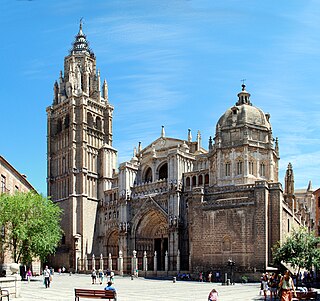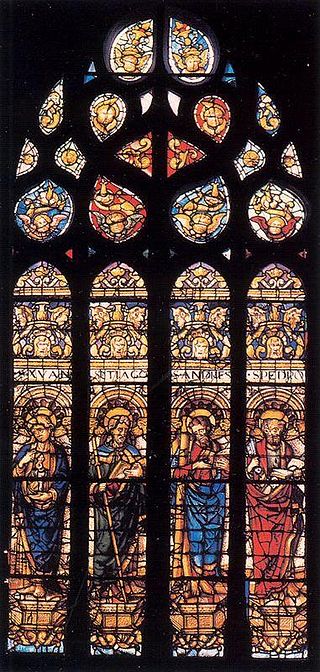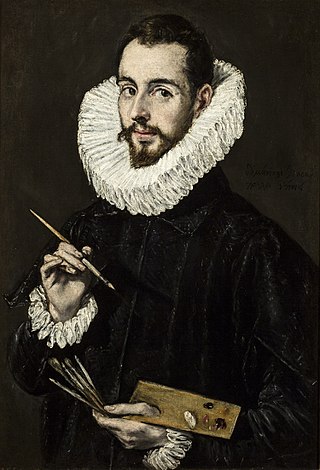
Rodrigo Díaz de Vivar was a Castilian knight and warlord in medieval Spain. Fighting with both Christian and Muslim armies during his lifetime, he earned the Arabic honorific as-Sayyid, which would evolve into El Cid, and the Spanish honorific El Campeador. He was born in Vivar, a village near the city of Burgos. As the head of his loyal knights, he came to dominate the Levante of the Iberian Peninsula at the end of the 11th century. He reclaimed the Taifa of Valencia from Moorish control for a brief period during the Reconquista, ruling the principality as its Prince from 17 June 1094 until his death in 1099. His wife, Jimena Díaz, inherited the city and maintained it until 1102 when it was reconquered by the Moors.

The Spanish Golden Age is a period of flourishing in arts and literature in Spain, coinciding with the political rise of the Spanish Empire under the Catholic Monarchs of Spain and the Spanish Habsburgs. The greatest patron of Spanish art and culture during this period was King Philip II (1556–1598), whose royal palace, El Escorial, invited the attention of some of Europe's greatest architects and painters, such as El Greco, who infused Spanish art with foreign styles and helped create a uniquely Spanish style of painting. The period is associated with the reigns of Isabella I, Ferdinand II, Charles V, Philip II, Philip III, and Philip IV, when Spain was at the peak of its power and influence in Europe and the world.

The Cathedral of Saint Mary of Burgos is a Catholic church dedicated to the Virgin Mary located in the historical center of the Spanish city of Burgos. Its official name is Santa Iglesia Catedral Basílica Metropolitana de Santa María de Burgos.

Diego Siloe (anglicized) or Diego de Siloé was a Spanish Renaissance architect and sculptor, progenitor of the Granadan school of sculpture. He developed the majority of his work in Andalusia.
Gonzalo de Salazar was an aristocrat, and leader of several councils that governed New Spain while Hernán Cortés was traveling to Honduras, in 1525−26.
Rodrigo de Ceballos was a Spanish composer.
Francisco Herrera the Younger was a Spanish painter and architect.
Alfonso Fernández de Palencia (1423–1492) was a Castilian royal secretary, historian, and humanist scholar. He first served Enrique IV of Castile and later played an active role in the political intrigue that ultimately brought Fernando II to Castile and put Isabel I on the throne. His chronicles, the Décadas, are an important historical source for this period.

The Primatial Cathedral of Saint Mary of Toledo, otherwise known as Toledo Cathedral, is a Roman Catholic church in Toledo, Spain. It is the seat of the Metropolitan Archdiocese of Toledo.
Nicolás de Vergara el Mozo was a Spanish sculptor, architect, blacksmith and glassmaker. He worked in the Toledo Cathedral, where he was master of works, and in other religious and civil buildings. He was the son of the architect and sculptor Nicolás de Vergara el Viejo and Catalina de Colonia, and brother of Juan de Vergara. He was also the nephew of the master glassmakers Arnao de Vergara and Arnao de Flandes and grandson of Arnao of Flanders the Elder.

Arnao de Flandes or Arnao de Flandes the Elder was a master glassmaker born in Flanders at an unknown date in the second half of the 15th century. He is believed to have moved to Spain between 1480 and 1490 and set up a workshop in Burgos, producing work for Avila Cathedral (1497), Palencia Cathedral (1503) and Burgos Cathedral (1511–1515).

The Battle of Linuesa was an action fought on 21 December 1361 in the city of Huesa, Kingdom of Jaén. The battle was fought between the Kingdom of Castile and the forces of the Emirate of Granada. The battle resulted in a victory for the forces of the Kingdom of Castile.

Philip of Castile was an Infante of Castile and son of Ferdinand III, King of Castile and León, and his first queen, Beatrice of Swabia. He was Lord of Valdecorneja, and, according to some sources, Knight of the Order of the Temple, in one of those churches, the Church of Santa María la Blanca in Villalcázar de Sirga, he was buried in a coffin adorned with emblems of the Templars.

Cornelio Schut or Cornelis Schut III was a Flemish painter who was active in Seville, Spain during his entire career. He was one of the leading Flemish painters working at that time in Seville and he was very close in style to Murillo.

Jorge Manuel Theotocópuli de las Cuevas was a Greek-Spanish painter and architect. He was the only son of the iconic painter, Doménikos Theotokópoulos, called "El Greco".

Iglesia de San Nicolás de Bari is a Catholic church on Fernán González street in Burgos, Spain, located next to the Camino de Santiago, behind the Cathedral of Burgos. It is mainly known for having one of the largest altarpieces in Spain and the only one carved in limestone.

Nuño González I de Lara, nicknamed el Bueno, was a Castilian nobleman, royal counsellor and military leader. He was the head of the House of Lara and a close personal friend of Alfonso X. The king's policies often stymied his efforts to increase the power and wealth of his house, and in 1272 he led many prominent noblemen into open rebellion. Restored to favour the next year, he died defending the castle of Écija from a Moroccan invasion.

The Convento de San Pedro Mártir is a convent located in Toledo, Spain. The Dominican convent was moved in 1407 from its location outside the walls to the houses donated by Doña Guiomar de Meneses. through its successive extensions and modifications, became one of the richest and most important convents of the city.

Luis Leon Masson was the son of Nicolás François Masson, by profession a transporter and Louise Sophie Besneé. He is one of the most prominent photographers to work in Spain in the first decades of photography. His activity as a photographer highlights his topographical work on the architectural and landscape heritage of Andalusian cities, mainly Seville, as well as important contributions from other Castilian cities, as well as his reproductions of Murillo's pictorial work.













